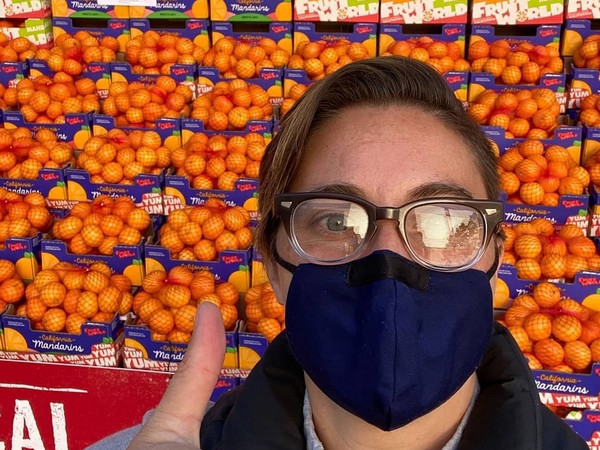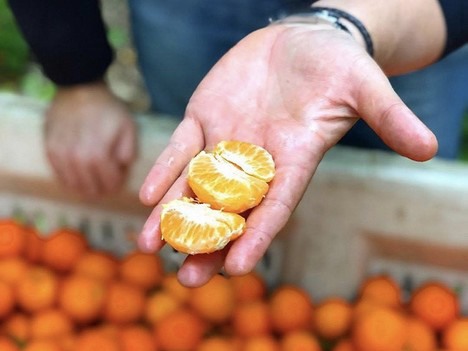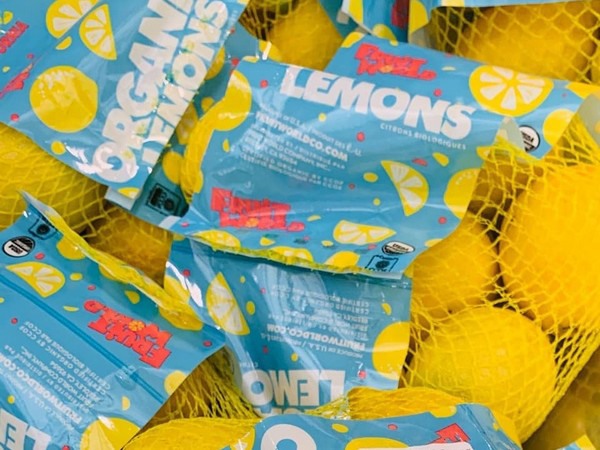California organic and conventional citrus is moving well as the state begins moving into production on some new varieties this month.
Mandarins: “Everything was about two to four weeks late this year on conventional and organic mandarins,” says Bianca Kaprielian of Fruit World in Reedley, CA. She notes conventional supplies are strong as is demand. “The biggest issue is getting enough harvesting in around the fog and rain,” says Kaprielian.
Meanwhile the organic crop has been lighter this year. “The heat and prolonged warm weather may have affected the crop so we’re limited on organic mandarins, but demand is strong,” says Kaprielian. She notes the strong demand looks promising for Fruit World which will have more organic acreage in the coming years.
Given the late start, Kaprielian says the end of the season could stretch out as well—Fruit World usually wraps up mandarin production in early May.
 Bianca Kaprielian of Fruit World says organic and conventional mandarins have been two to four weeks late this year.
Bianca Kaprielian of Fruit World says organic and conventional mandarins have been two to four weeks late this year.
As for pricing, it’s been stable which is welcome following last year’s downward market pressure. “There were new players in the market and there was downward pressure last year. But it’s come up to a more sustainable level. Organic pricing is on trend for the past few years—holding where it’s been,” says Kaprielian.
Tangos meanwhile will come on slightly later than usual. “Page usually come on right after the Clementines but this year we have more overlap. Clementines are going a little later and Page were ripe a little earlier,” says Kaprielian. Fruit World will also have their proprietary late Page variety in January.
 Pricing has been stable on conventional mandarins and holding on organic mandarins.
Pricing has been stable on conventional mandarins and holding on organic mandarins.
Oranges: Industry wide, the organic navel crop is down. There’s no gap expected between California Navels and Valencias, though supplies will tighten up into March. This is making for larger sizes across the industry. “Flavor and color have been good,” says Kaprielian. “Because of the warmer weather, the crop took longer to color up but we’re into really good eating fruit right now.”
On conventional oranges, Fruit World is trying its first year at selling conventional Navels from its prized ranch, Sky Ranch, a site valued for attributes such as the soil’s mineral content and microclimate says Kaprielian. “At Sky Ranch we have an Heirloom Washington Navel block we’re transitioning to organic,” says Kaprielian, adding that her grandfather planted this block. Demand for conventional oranges continues to look strong. “It started at the beginning of the pandemic when people were looking for Vitamin C and oranges are good value,” says Kaprielian. “This summer we also saw orange demand was very strong and we’re still seeing it into the winter.”
As for orange pricing, it’s currently stable. Fruit World’s conventional heirloom navels will hit the market starting in mid-January, while their organic navels are currently in full production.
Minneolas: This crop is also a few weeks behind as the fruit has been slower to color up. Production began last week and sizing is peaking a little bigger than in typical years. “Organic minneolas started in the desert, then we’ll move to the Central Valley,” says Kaprielian.
Demand looks good, if not slightly up, from last year and Kaprielian believes pricing will be similar to last year.
Lemons: Currently production for organic lemons is out of the desert region and the Central Valley. “The US market received Mexican imports much later this year than in past years,” she says, noting the imports are just now clearing out. “That definitely affected California fruit as we started up. But since the beginning of December, demand for California lemons has picked up and we’re finally normalizing.”
 Demand has picked back up on lemons now that Mexican imports have largely cleared out.
Demand has picked back up on lemons now that Mexican imports have largely cleared out.
That also kept pricing on California fruit down and only in the past few weeks has it come up to be similar to last year’s price. “It will be stable now that the imports have cleared and should stay stable until April when supplies start tightening up,” says Kaprielian.
Specialty citrus: In mid-January, Fruit World will begin harvesting their organic Cara Caras, followed by Blood Oranges at the end of January. “The crop is looking great. We could harvest the Cara Caras now, but we prefer to wait until the flavor is at its peak—color looks good at this point but we want the sugars to develop a little more,” says Kaprielian. She notes there’s a slight increase in the Cara Cara crop and Fruit World will also have some Cara Caras from a production block that is transitioning to organic.
For more information:
Bianca Kaprielian
Fruit World Co.
Tel: +1 (559) 650-0334 x2
bianca@fruitworldco.com
www.fruitworldco.com

